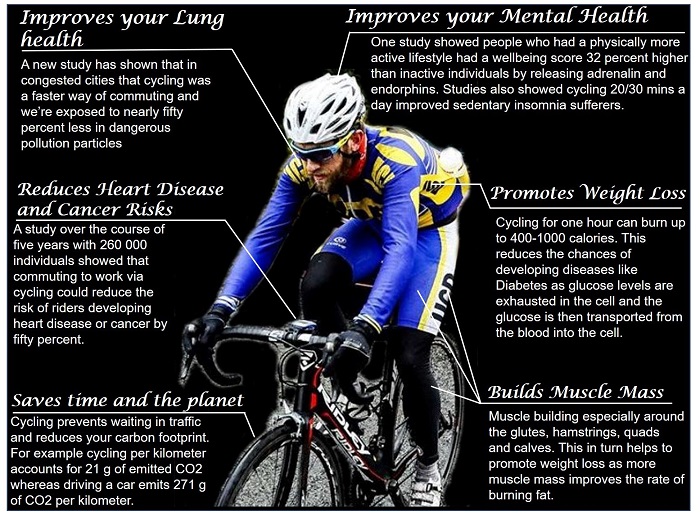Cycling: the miracle pill against cancer?

Photo Credit: Shutterstock/Fischer Fotostudio
Cancer is one of the biggest killers in Ireland, accounting for 30 percent of deaths or about 9000 deaths each year in the country. The causes of a wide variety of cancers can be broken into three external agents that interact with a person’s genetic factors. These include physical carcinogens, such as ultraviolet (UV) light, chemical carcinogens, like components of tobacco smoke, and biological carcinogens, such as infections from certain viruses, bacteria, or parasites.
My daily activity working as a cancer biologist is growing human cancer cells, seeding them (setting up an experiment) and then testing whether certain genetic manipulations can kill or reduce the ability of cancer cells to grow, therefore identifying possible genetic vulnerabilities. But what I want to talk about is how we can mitigate our chances of developing deadly diseases such as cancer. Many of us recognize concepts such as “Mitigation” from the COVID-19 disease pandemic. Mitigation is a crucial step reducing the spread of the disease by lockdown, practicing good respiratory hygiene and social distancing. Knowing this type of strategy, can we mitigate against developing cancer?
There are a number of simple lifestyle changes we can make to reduce the risk of developing cancer. Taking steps like removing tobacco use, drinking less alcohol, reducing the amount of red meat in your diet, increasing your vegetable intake, protecting your skin from UV light (the sun) and increasing your physical activity can reduce your chances of contracting cancer by 30 to 50 percent. This demonstrates that it is possible to mitigate against some of the risk factors of cancer. Luckily, physical activity is one of my favourite past times -- more specifically, cycling. Every week before the outbreak of COVID-19 I would cycle to and from work. Bray to UCD gave me a healthy diet of 40 kms of cycling a day, 160 kms a week and 8500 Kms a year. Cycling can greatly improve both your mental and physical well-being. As shown in Figure 1, cycling, as well as being environmentally friendly, has a wide variety of benefits including improving your mental well-being, your lung health, reducing the risk of heart disease, and promoting weight loss.

Figure 1: The benefits of cycling
One relatively easy way to get your 30 minutes of moderate physical activity in during the day is to commute to work via walking or cycling. A previous study had shown that a meta-analysis of 173,146 participants that actively commute by cycling or walking could reduce the risk of poor cardiovascular outcomes (Hamer et al., 2008, Preventive Medicine). This study was limited by the number of cardiometabolic endpoints (hypertension) and did not differentiate between the different types of exercise that was undertaken. A more recent study of 260,000 individuals, over a period of five years, investigated the association between different types of active commuting and incident cardiovascular disease (CVD), cancer, and all-cause mortality (Celis-Morales., 2017, The British Medical Journal). To summarize what they showed was that cycling alone was associated with the lowest risk of these outcomes as well as lower risks of all-cause mortality and cancer, with dose dependent correlations for all outcomes. Taken together, this means the more you cycle the less likely you will get cancer or CVD. These observations were independent of sex, age, deprivation, ethnicity, smoking status, physical activity, sedentary behaviour, dietary patterns, body mass index and comorbidities. The risk reductions observed by cycling to work may be due to the contribution of cycling to overall daily physical activity. The WHO recommends 150 minutes of moderate-intensity aerobic physical activity for adults aged 18-64 throughout the week. As you can see (Figure 2) cycling alone has greater physical activity and fitness over others, for example walking commuters. Ninety percent of cycle commuters hit the recommended physical guidelines compared to only 54 percent of walking commuters. The reduced risk of cycle commuting could be explained by the fact that they are more likely to reach the recommended amount of physical activity.

Figure 2: Percentage of people by commute type that meet daily recommended amount of physical activity
(photo credt: Popular Science, 20 April 2017)
So does this mean that cycling will prevent diseases like cancer or heart disease? It will help in preventing diseases, but this is not a causative relationship meaning that these diseases are not just caused by lack of physical activity but by a number of complex factors. And like any good scientific studies, they need be reproducible in other studies examining these observations. But there is definitely no harm in incorporating cycling to work into your daily physical activity, as long as you cycle safely and respect the stakeholders of the road.

About the author
Niall Quinn, PhD, is currently a postdoctoral scholar in Colm Ryan's group at SBI and an avid cyclist. He is pictured above with his nephew, Sean.

